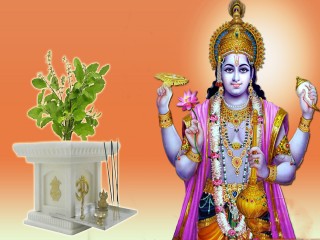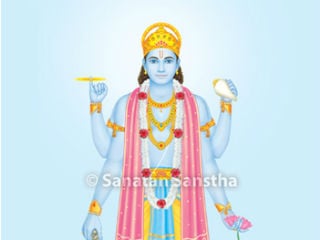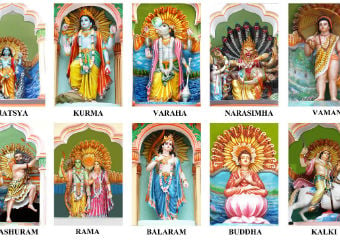
Tulsi is a sacred plant. The plant grows to a height of 3-4 feet. There are two varieties of tulsi – black (Shrikrushṇa) and white. This plant has vertical springs which bear racemes. Most probably its root name is tulas, and tulsi is its Sanskrut version.
Worship of Shri Vishṇu without tulsi leaves goes in vain, because without offering tulsi leaves or without sprinkling the Naivedya(Food offered to the Deity as part of ritualistic worship)with water using the tulsi leaves, Shri Vishṇu does not partake of the offering. Looking at, touching, meditating upon, praying to, worshipping,planting or eating tulsi leaves can cleanse the demerits of many past births. It is said that all Deities reside in this plant right from the roots to its shoots.
One objective of ritualistic worship is that the Idol being worshipped should get charged with Chaitanya (Divine consciousness) and this in turn should help us progress spiritually. To generate this Chaitanya, a substance that has greater ability to attract the pavitraks (Subtle most particles containing Chaitanya) of that Deity from as far as the Maharlok (The fourth higher subtle-region of the universe) is offered to the Idol. Red flower shave the ability to attract the pavitraks of Gaṇapati, bel leaves that of Shiva, tulsi leaves that of Shri Vishṇu etc. Hence, tulsi leaves are offered to Shri Vishṇu.
1. An icon of detachment
A tulsi plant symbolises detachment. Once, while performing the ritual of tula (Weighing with food grains, gems etc.) of Shrikrushṇa, despite putting diamonds, precious stones, gold etc. in one pan, the other pan with Shrikrushṇa seated in would just not balance. Finally, Rukmiṇi placed a tulsi leaf over the wealth and only then did the pan balance. Through this incident Shrikrushṇa has taught that He can be won over not with wealth, but only with detachment. In Marathi, the term, ‘Placed a tulsi leaf on the house’ is often used, which means sacrificing the worldly life to serve the Nation and Dharma.
2. Non-duality between Shri Vishnu and Shankar
Shri Vishṇu and Shiva are one and the same.The similarity with respect to ritualistic worship is as follows – The inherent characteristics of a commodity change with time. On Kartiki Ekadashi (Eleventh day of the Hindu lunar month of Kartik), tulsi leaves develop the ability to imbibe pavitraks of Shivaand bel leaves of Shri Vishṇu. Hence, on this day Shiva is offered tulsi leaves & Shri Vishṇu is offered bel leaves. The psychological explanation is – this is done to illustrate the non-duality between Hari (Shri Vishṇu) and Har (Shankar).

 Forms and Family of Shri Vishnu
Forms and Family of Shri Vishnu The ten Incarnations of Shri Vishnu
The ten Incarnations of Shri Vishnu Science of the idol of Shri Vishnu
Science of the idol of Shri Vishnu Vaikunth chaturdashi is an invaluable opportunity granted to us to worship Deity Shri Vishnu
Vaikunth chaturdashi is an invaluable opportunity granted to us to worship Deity Shri Vishnu Why a specific Name of Shri Vishnu is used for a specific task ?
Why a specific Name of Shri Vishnu is used for a specific task ?